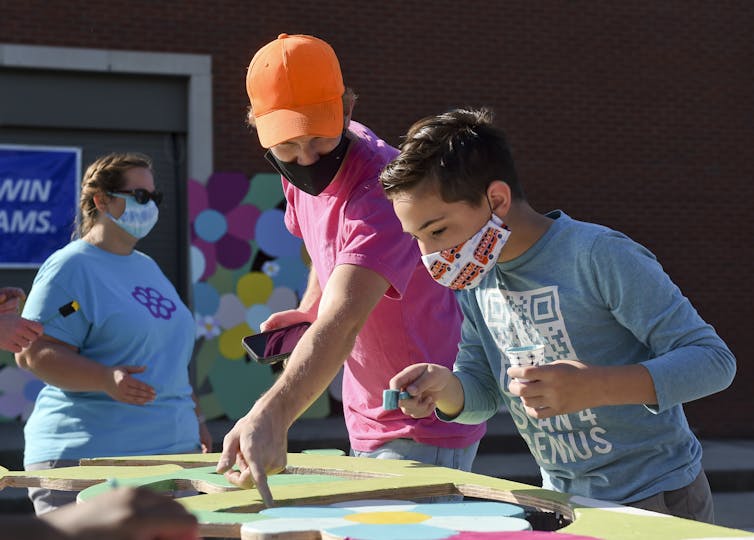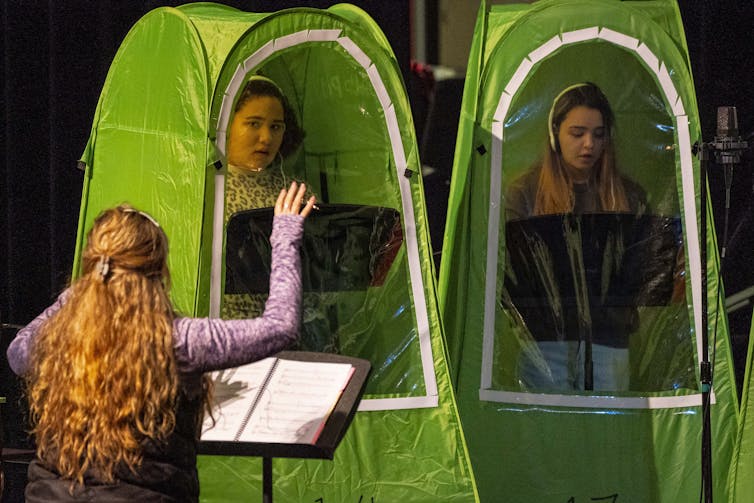Ben Hasty/MediaNews Group/Reading Eagle via Getty Images
Ryan D. Shaw, Michigan State University
Parents can watch their kids draw and paint at home or perform in school music concerts and dance recitals. But they may not know how their school arts program compares with others around the country.
As a music education professor and a researcher who studies arts education policies, I know that access to and the quality of arts programs vary greatly among states, districts and even schools within the same district.
Additionally, I see that disruptions from the pandemic are threatening the already tenuous status of the arts in public schools.
Who gets to study art and music?
Music education first made its way into American public schools in Boston in the 1830s. It started with singing instruction, with instrumental music to follow later in the century. Today, arts programs in K-12 schools include visual arts, music, theater, dance and multimedia or design.
A congressionally mandated study from 2011 offers a snapshot of what’s available to kids. Back then, 94% of public elementary schools reported that they offered music instruction, and 83% offered visual arts. Theater (4%) and dance (3%) were much less common.
Data also shows that, at least at the high school level, larger schools and traditional public schools offer more arts courses than do smaller schools and private or charter schools.
But the more locally one looks, the more disparities emerge. For example, only 22% of high schools with high concentrations of poverty offer five or more visual arts courses, compared with 56% of high schools with low concentrations of poverty. Some evidence suggests schools with mostly white students offer significantly more music offerings than schools in the same metropolitan area that serve mostly students of color.
Disparities also exist in terms of how qualified arts teachers are in different schools. In Utah, for example, fewer than 10% of elementary school students receive music instruction from certified specialists. And in my own analysis of music education in Michigan in 2017-2018, I found only two-thirds of urban schools had certified music teachers, compared with almost 90% of suburban schools.

Ben Hasty/MediaNews Group/Reading Eagle via Getty Images
Cuts to instruction
These findings offer clues to how the arts are currently positioned in U.S. schools.
Although the arts were considered a core subject in the 2001 federal No Child Left Behind Act, they were not factored into annual testing or related sanctions against underperforming schools. As a result, instructional time in the arts was cut back.
In two studies from 2007 to 2008, schools indicated that they had cut an average of 145 minutes per week across the nontested subjects, lunch and recess. Where visual art and music were cut back, it was for an average of 57 minutes per week.
Because states determine curricular requirements and other policies, the landscape varies. Arkansas, for example, requires 40 minutes of elementary school art and music per week, while Michigan has no requirement for either. Only 32 states consider the arts a core subject.
Furthermore, a school superintendent’s priorities may be the deciding factor in whether a school district’s arts education is robust or merely an afterthought. In a 2017 study I did on arts education in Lansing, Michigan, a midsized school district that had cut staff to fill a budgetary gap, I found elementary schools offered a single music and art class once every eight weeks.
Benefits of arts education
Arts education has been associated with increased cognitive ability, academic achievement, creative thinking, school engagement and so-called “soft skills” like compassion for others. However, many of these studies are correlational rather than causal. It may be that more advanced and more privileged students pursued arts education in the first place.
Still, research on the benefits of the arts has spurred many schools to invest in arts integration. This approach marries arts content with traditional academic subjects. For example, students might learn history though theater performances. Other policies aim to use arts integration and artist residencies to improve test scores, attendance, graduation rates and other metrics.
Some arts education advocates have pushed back with a rallying cry of “art for art’s sake.” They worry that if arts education is always justified by its impact on math and reading achievement, it may be viewed as nice but not necessary.
More recently, arts education proponents talk about access to a well-rounded, rich curriculum as an equity issue. This has led large districts in Chicago, Seattle, Boston and Houston to slowly chip away at disparities in arts education.

David Ryder/Getty Images
COVID-19 and arts education
Hands-on arts classes made for an awkward fit with remote learning when schools suspended in-person instruction during the COVID-19 pandemic. Many music teachers reported that they were told not to hold live virtual classes with students, and that their students did not engage much with their assignments.
Yet when schools returned to in-person instruction, frustrations and confusion continued to abound. After a community choir rehearsal in Washington state turned into a superspreader event, singing and playing wind instruments were banned in many schools. In visual arts classes, the sharing of materials was an issue. And across schools, arts teachers were limited by social distancing restrictions and guidelines around keeping groups of students separated.
[Over 110,000 readers rely on The Conversation’s newsletter to understand the world. Sign up today.]
Preliminary results of a survey I’m conducting suggest that high school music class enrollment has suffered during the pandemic. This may be as a result of students exiting the public school system or of safety concerns regarding singing and performing in large groups.
What’s next?
As more normalcy returns to schools, will arts education programs rebound? Two forces may help determine the answer.
On one hand, the concern over so-called learning loss is pushing school districts to invest in extra tutoring and coaching in traditionally tested subjects like math and English language arts. As in the aftermath of No Child Left Behind, this could crowd out instructional time for the arts.
However, the pandemic has also drawn more attention to mental health and student wellness. Arts classrooms may provide a natural place for social and emotional learning because of the focus on collaboration, goal-setting and emotional expression.
There are also government and nonprofit efforts to make arts education more consistent across the country. Proposed legislation like the Arts Education for All Act would expand arts education in K-12 public schools and require more data reporting on arts achievement at the state and federal levels.
For now, access to school arts education remains unequal in the United States. The COVID-19 pandemic could help focus attention on these inequities and spur solutions, or it could further complicate the perennially shaky footing of the arts in schools.
Ryan D. Shaw, Assistant Professor of Music Education, Michigan State University
This article is republished from The Conversation under a Creative Commons license. Read the original article.

